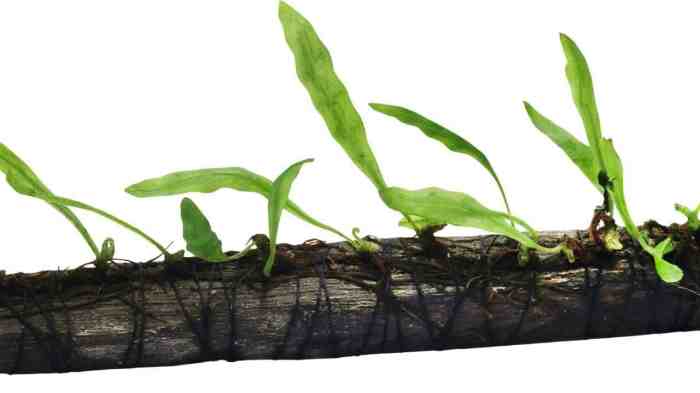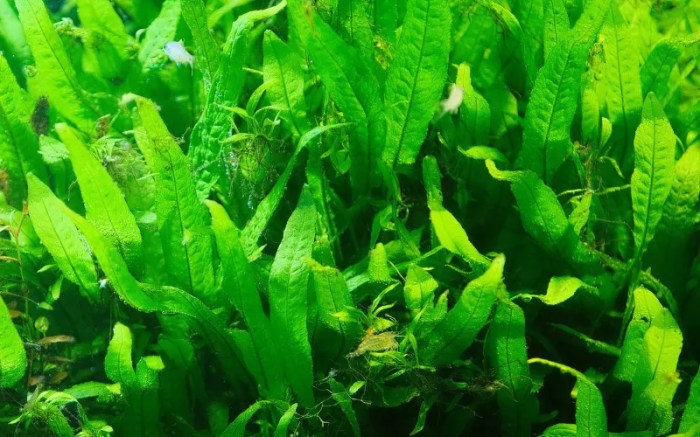How to trim Java fern: it’s a question every aquarium enthusiast grapples with at some point. Java ferns, with their lush, feathery fronds, add a touch of elegance to any tank. But like any plant, they need regular maintenance to thrive.
Understanding the best trimming techniques ensures healthy growth, prevents overcrowding, and even allows you to propagate new plants.
This guide delves into the intricacies of Java fern trimming, covering everything from the tools and techniques to post-trimming care. We’ll explore the ideal water parameters and lighting conditions to optimize growth, ensuring your Java ferns flourish. By the end, you’ll be confident in your ability to trim your Java ferns like a pro, promoting a vibrant and thriving aquatic ecosystem.
Preparing for Trimming

Before you dive into trimming your Java fern, it’s essential to gather the right tools and ensure they are properly sanitized. This will prevent the introduction of harmful bacteria or parasites into your aquarium, safeguarding the health of your fish and plants.
Tools for Trimming Java Fern
The tools needed for trimming Java fern are simple and readily available. You’ll need:
- Sharp Scissors or Pruning Shears:These are essential for making clean cuts through the tough rhizomes and leaves of the Java fern. Choose a pair with sharp blades to avoid damaging the plant.
- Tweezers:Tweezers are helpful for removing smaller pieces of Java fern or for accessing hard-to-reach areas within the aquarium.
Sanitizing Trimming Tools
Proper sanitation of your trimming tools is crucial to prevent the spread of infections and diseases in your aquarium. Here’s how to do it:
- Wash with Hot Water and Soap:Start by thoroughly washing your tools with hot water and a mild soap. This will remove any visible debris or organic matter.
- Rinse Thoroughly:Rinse your tools thoroughly under running water to remove all traces of soap. Ensure no soap residue remains, as it can be harmful to your fish and plants.
- Disinfect with Bleach Solution:For a more thorough disinfection, soak your tools in a 10% bleach solution for 10 minutes. This will kill most harmful bacteria and viruses.
- Rinse Again:After soaking, rinse your tools again with clean water to remove all bleach residue. Ensure no bleach remains, as it can be toxic to your aquarium inhabitants.
- Air Dry:Allow your tools to air dry completely before using them in your aquarium. This will prevent water droplets from contaminating the aquarium.
Preparing the Java Fern, How to trim java fern
Before trimming, it’s important to prepare the Java fern for a smooth and efficient process. This involves:
- Identify the Growth Points:Java ferns grow from a central rhizome, a horizontal stem-like structure. The growth points, where new leaves emerge, are typically located at the tips of the rhizome. Identify these points before trimming, as you’ll want to avoid cutting them off.
- Remove Excess Growth:Trim any leaves that are damaged, withered, or excessively long. These can be removed without harming the plant.
- Trim for Desired Shape:You can trim the Java fern to achieve your desired shape and size. This is particularly useful if you’re aiming for a specific aesthetic or if the plant is becoming too large for your aquarium.
Trimming Techniques
Trimming Java fern is a straightforward process that involves removing excess growth to maintain the plant’s shape and encourage new growth. Different trimming methods are available, each with its advantages and disadvantages.
Different Trimming Methods
There are several methods for trimming Java fern, each with its own advantages and disadvantages:
- Scissors or Pruning Shears:This method is suitable for removing large sections of the fern, especially if you are aiming for a specific shape. Using sharp scissors or pruning shears ensures a clean cut, minimizing damage to the plant.
- Sharp Knife:A sharp knife is a good option for trimming individual fronds or removing smaller sections of the fern.
It allows for precise cuts and reduces the risk of damaging other fronds.
- Hand Trimming:This method involves using your fingers to break off individual fronds or sections of the fern. It is a gentle method that minimizes stress on the plant, but it may not be as precise as using tools.
Effectiveness of Trimming Methods
The effectiveness of different trimming methods depends on the desired outcome and the size and shape of the Java fern.
Trimming Java fern is a simple process, but it’s important to understand the plant’s growth habits. You can prune away excess fronds to maintain a healthy, balanced aquarium. While you’re learning about aquarium care, you might be curious about feeding your fish.
Can Goldfish Eat Carrots: A Guide to Safe Veggie Treats can help you find out what treats are safe for your aquatic companions. Back to your Java fern, be sure to remove any decaying or damaged fronds to prevent algae growth and keep your aquarium clean.
| Method | Effectiveness | Advantages | Disadvantages |
|---|---|---|---|
| Scissors or Pruning Shears | High | Clean cuts, suitable for large sections | Can be difficult to control for precise cuts |
| Sharp Knife | Moderate | Precise cuts, suitable for small sections | Can be more time-consuming |
| Hand Trimming | Low | Gentle on the plant, minimal stress | Less precise, may not be suitable for large sections |
Advantages and Disadvantages of Trimming Methods
The choice of trimming method depends on the desired outcome and the size and shape of the Java fern.
- Scissors or Pruning Shears:
- Advantages:Clean cuts, suitable for large sections, efficient for removing unwanted growth.
- Disadvantages:Can be difficult to control for precise cuts, may damage other fronds if not used carefully.
- Sharp Knife:
- Advantages:Precise cuts, suitable for small sections, allows for more control over the trimming process.
- Disadvantages:Can be more time-consuming, requires a steady hand, may not be suitable for large sections.
- Hand Trimming:
- Advantages:Gentle on the plant, minimal stress, suitable for delicate fronds.
- Disadvantages:Less precise, may not be suitable for large sections, can be time-consuming.
Post-Trimming Care: How To Trim Java Fern
After trimming your Java fern, it’s important to provide proper care to ensure the plant thrives and new growth emerges. This section covers managing trimmed Java fern pieces, propagating new plants, and maintaining a healthy environment for your Java fern.
Managing Trimmed Java Fern Pieces
After trimming, you’ll have several pieces of Java fern. These pieces can be used to propagate new plants. However, it’s important to handle them with care to avoid damaging the rhizomes.
- Avoid Overcrowding:Ensure the trimmed pieces have enough space in the tank. Overcrowding can lead to competition for nutrients and light, hindering growth.
- Secure the Pieces:If you’re placing trimmed pieces in a new location, secure them to a rock or driftwood using fishing line or a rubber band. This prevents them from floating away and ensures they stay anchored.
- Monitor for Algae Growth:Java fern can be susceptible to algae growth, especially if the water parameters are not optimal. Monitor the trimmed pieces for any signs of algae and remove it promptly.
Propagating New Plants
Java ferns are easily propagated through division. When trimming, you’ll naturally create new plants from the pieces.
- Rhizome Division:The most common method is to separate the plant along the rhizome. The rhizome is the horizontal stem that runs along the base of the fern. Each piece of rhizome with a few leaves attached can develop into a new plant.
- Leaf Propagation:Java ferns can also be propagated from leaves. Cut a leaf into smaller sections, about 2-3 inches long, and attach them to a rock or driftwood. New plants will emerge from the leaf sections.
- Time for New Growth:New plants will typically emerge from the trimmed pieces within a few weeks, depending on the water conditions and the amount of light.
Post-Trimming Maintenance
Maintaining the health of your Java fern after trimming is essential for successful growth and propagation. Here is a checklist of key tasks to ensure your Java fern thrives:
- Water Parameters:Monitor the water parameters, including temperature, pH, and ammonia levels, to ensure they are within the optimal range for Java fern growth.
- Light:Provide adequate lighting for your Java fern. Java ferns prefer medium to low light conditions.
- Nutrients:Ensure the tank has adequate nutrients, especially iron, which is essential for Java fern growth.
- Algae Control:Monitor for algae growth and address it promptly. Algae can compete with Java fern for nutrients and light.
- Regular Trimming:Continue to trim your Java fern as needed to maintain its shape and prevent overgrowth.
Common Trimming Issues

Trimming Java fern, while generally straightforward, can sometimes lead to complications. Understanding these common issues and their causes is crucial for preventing them and ensuring the health of your plant. This section delves into the most frequent problems encountered during trimming and offers solutions to prevent future complications.
Over-Trimming
Over-trimming is a common issue that can weaken the Java fern, making it susceptible to diseases and inhibiting its growth. Over-trimming occurs when you remove too much of the plant’s foliage, depriving it of the necessary surface area for photosynthesis.
- Cause:Over-trimming can be caused by inexperienced aquarists who are unsure how much to trim or by a desire to maintain a specific aesthetic.
- Solution:The best approach is to trim only the necessary portions of the plant, focusing on removing dead or damaged leaves.
- Prevention:It’s important to understand the growth habits of Java fern and trim only what is needed to maintain its desired shape and size. Regularly monitoring the plant for signs of overgrowth can help prevent excessive trimming.
Damaged Roots
Damaged roots can hinder the plant’s ability to absorb nutrients and water, leading to stunted growth and potential death. This can happen during trimming, especially when using sharp tools or handling the plant carelessly.
- Cause:Using sharp scissors or knives without proper care can easily damage the delicate roots of the Java fern.
- Solution:When trimming, it’s crucial to use a sharp but blunt tool, such as a pair of blunt-tipped scissors or a dedicated aquatic plant trimming tool.
- Prevention:Avoid using sharp blades and handle the plant with care, particularly when working near the rhizome and roots. Consider using a tool specifically designed for trimming aquatic plants.
Improper Cutting Technique
Incorrect cutting techniques can lead to uneven growth and a less appealing appearance. It’s important to understand the correct way to trim Java fern to ensure its healthy growth and maintain its aesthetic appeal.
- Cause:Trimming at the wrong angle or cutting too close to the rhizome can result in uneven growth and a disheveled appearance.
- Solution:Trim the leaves at a 45-degree angle, leaving a small portion of the leaf attached to the rhizome. This encourages new growth and maintains a natural appearance.
- Prevention:Practice proper cutting techniques and familiarize yourself with the ideal trimming angle for Java fern.
Final Thoughts
Trimming Java fern isn’t just about aesthetics; it’s about promoting healthy growth and creating a balanced aquarium environment. By following the steps Artikeld in this guide, you’ll be equipped to trim your Java ferns with confidence, ensuring their continued vitality and the overall well-being of your aquatic ecosystem.
Remember, a little attention to detail goes a long way in maintaining the beauty and health of your Java fern plants.